6 Putting It
into Practice
Armed with a scale
and a notation, Partch only needed
to write some music and get it performed.
Writing the music was no more of a
problem than for the average "ET composer",
but performance? That was much easier
said than done: on what could such
music be performed? Certainly not
by current instruments, which were
geared to ET. And by whom? Certainly
not by current performers, who would
not understand a note of it.
Instruments
He had one or two
instruments which he was using in
his experimental work, including a
modified viola and a simple "harmonic
canon" which comprised a series of
parallel strings stretched over a
sounding-box. These strings could
be tuned to the same pitch and then
JI intervals (relatively) quickly
tuned by carefully placing moveable
wooden bridges. But to write only,
say, "duos for modified viola and
harmonic canon" was a bit limiting,
and in any case there was only one
performer - himself.
He was faced with
an apparently insurmountable problem,
for he was not content to remain a
mere theoretician. His solution was
again pragmatic, but also one with
which he set himself a truly appalling
task. Partch would build an entire
orchestra of instruments of his own
invention.
This task took him
thirty years, a process of continual
development, the results of which
are shown in the table. Some of the
instruments were adaptations of existing
instruments, for instance viola, guitar,
koto, and most notably the Chromolodeon,
which was a re-tuned harmonium. A
few are fairly straightforward redevelopments
of conventional instruments - Bass
Marimba, hand instruments, and
Blo-Boy, which is an organ
foot-bellow coupled to a few re-tuned
organ pipes. Some are more radical
redevelopments: the Diamond Marimba
is neatly laid out in the geometry
of the Incipient Tonality Diamond.
Finally, some (a lot) are entirely
original - weird and wonderful, and
beautiful to behold. Partch, quite
incidentally (and accidentally), won
numerous prizes for some of his instruments,
not for their musical qualities but
as works of plastic art - sculptures.
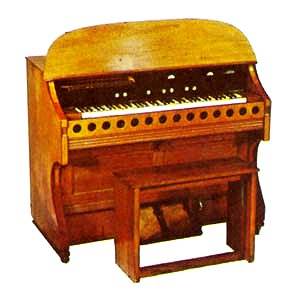 |
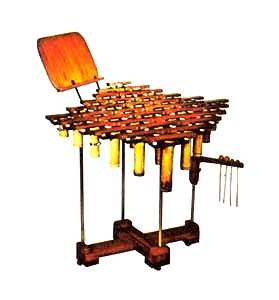 |
|
Chromolodeon
|
Diamond
Marimba
|
Some instruments
exist in several versions (distinguished
by roman numerals). These tended to
have differences in quality, and thus
newer versions did not supplant older
ones. The Harmonic Canon III
probably got its name, "Blue Rainbow",
from its striking sonority, bolder
and fuller than its predecessors,
and capable of truly incredible, magical
glissando effects. Where a newer version
did replace its predecessor, it is
suffixed "reconceived".
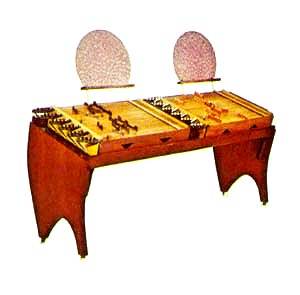 |
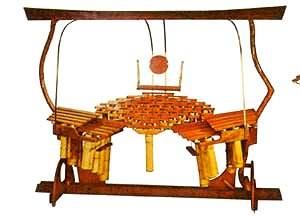 |
|
Harmonic
Canon III
|
Quadrangularis
Reversum
|
It would take a book
to describe and explain all these
instruments in detail, so I will limit
myself to giving the flavour of a
selected few. The Cloud-Chamber
Bowls were inspired by the scientific
apparatus invented by the physicist
Charles Wilson for tracing subatomic
particle interactions. Partch took
large glass domes as used in the apparatus,
tuned them and suspended them in a
wooden frame. When struck, they produce
a "bonging" sound somewhere between
a bell and a bottle.
Speaking of bottles,
the Zymo-Xyl had an amusing
history. The "Xyl" part is basically
a xylophone. The "Zymo" is taken from
the Greek for "fermentation": beyond
the wooden blocks is a row of inverted
bottles. One of his more enjoyable
researches involved locating bottles
of the required resonance, which required
that the contents be first disposed
of. These fragile components tended
to break (and require replacement)
at intervals, though whether broken
on purpose is not clear!
The Marimba Eroica
is a remarkable construction, comprising
just four wooden elements, the largest
of which is about eight feet long,
and requiring adjustable tuning. The
sound is incredible, deep and black,
like tuned bass drums, only
firmer and rounder. The Cone Gongs
were made from the nose cones of large
artillery shells, and the Spoils
of War include elements made from
cartridge-cases.
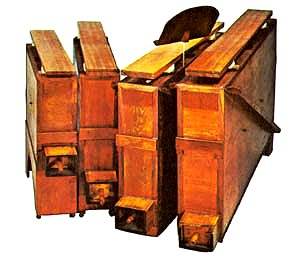 |
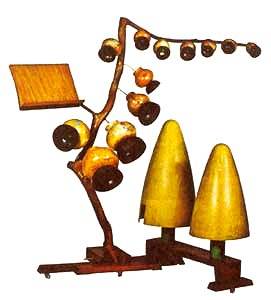 |
|
Marimba
Eroica
|
Cone Gongs
|
The Mazda Marimba
is not a true marimba because its
elements are not made of wood, but
the glass envelopes of various light
bulbs. Problems of finding one of
the required resonance were similar
to those encountered with the Zymo-Xyl,
only considerably less fun to resolve.
More so than the Zymo-Xyl or
Cloud-Chamber Bowls, this instrument
is extremely fragile. Its sound is
a gentle "plopping", so quiet that
this is the only one of Partch's instruments
allowed a small degree of electronic
amplification.
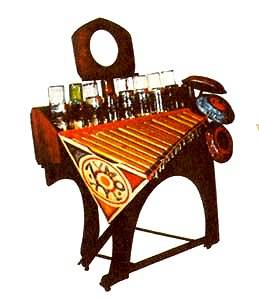 |
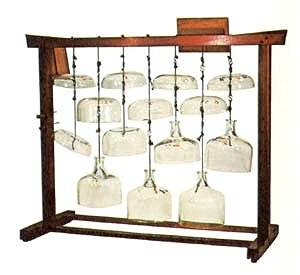 |
|
Zymo-Xyl
|
Cloud-Chamber
Bowls
|
Performers
Having developed
the scale, notation(s) and instruments,
one final task remained: to get the
music he had written performed. Again,
Partch had to meet a problem head-on,
though for once the description is
simple to the point of curtness! He
made himself proficient in each and
every instrument, then cultivated
a band of sympathetic musicians and
trained them all. Judging by the performances
available on record, training was
carried out to a very high standard,
at once demonstrating beyond any reasonable
doubt not only that instruments could
be devised to cope with a high resolution
JI, but also that music in 43-tone
JI is far from impossible to perform.
7 Partch's
Performance Philosophy
Harry Partch had
fairly radical ideas on the place
and purpose of music in human activity.
He saw music as a "servant", rather
than a "master", as something which
does not exist in isolation but interacts
with and enriches a dramatic experience.
This viewpoint, with its origins in
ancient history, clearly derives from
his strong objections to ritualised,
quasi-religious concert-giving. In
Genesis of a Music, he considers
this in great detail, re-appraising
in its light the work of many great
composers. In particular, he observed
that Wagner had come closer than any
to this philosophy, but then spoilt
it by what Partch, and quite a few
others for that matter, considered
a gross over-inflation. In Der
Abschied from Das Lied von
der Erde, he thought that Mahler
had scaled heights privileged to few.
Part and parcel of
this servant/master perspective was
his idea of the relationship between
music and words. He found it intensely
annoying that the words in opera,
which have the supremely important
role of conveying the essential drama,
are ruthlessly pulled about and distorted
to "fit" the music. He was not slow
to deduce that this is why the words
are generally unintelligible: words
are recognisable equally by their
rhythmic pattern, their "temporal
structure", as they are by the quality
of their sound. Opera composers destroyed
intelligibility by distorting the
"speech-rhythms" of words just as
effectively as if they had substituted
the wrong syllables! (of course, as
always, there are notable exceptions.)
Music, in Partch's philosophy, if
it did not serve the words, did not
serve its purpose in the vocal context.
He encapsulated his
philosophy in the term corporeal
music, music that exists physically,
in the "here and now", and not in
some abstract, intellectual vacuum.
Music was seen as "part of the action"
of a "total theatrical experience".
That this was not just some clever-dick
pronouncement was demonstrated by
pointing to the place allotted to
music in "natural" environments, such
as can be witnessed in "tribal" surroundings
the world over. Partch's musicians,
far from being placed in some secure,
distinct reservation (such as an orchestra
pit), formed part of the actual scene.
Musicians had to wear costumes like
the rest of the "cast". The form and
disposition of instruments was determined
by dramatic considerations. Special
lighting for the musical printed parts
was not necessary - Partch expected
his musicians to learn their parts,
just as the singers and actors had
to learn theirs - and "why not?" one
immediately asks.
8 For Posterity
Partch must have
been acutely aware of the volatile
nature of his practical work. Performances
of his music would be unlikely after
his death, as his music could only
be played on his instruments. These,
extremely delicate, temperamental,
and requiring hours (even days) of
careful setting up for a performance,
would in all likelihood become museum
pieces without his personal ministrations.
So, ever pragmatic, he provided a
chance of survival, at least historically,
for his music by starting up his own
recording company, "Gate 5", named
after the inauspicious premises in
which it operated. A number of recordings
were made, which have since entered
the catalogue of the Composers'
Recordings Incorporated (CRI)
label produced in the USA.
Oddly enough, his
masterpiece, the 70-minute long Delusion
of the Fury which formed the climax
of his life's work, was recorded not
by his own Gate 5 company, but by
CBS (now Sony) Records. This came
as a 2-LP set with a generously illustrated
booklet, and an additional LP of demonstrations
of each of his instruments, though
this last was sadly missing from sets
imported into the UK (it was never,
as far as I am aware, formally released
in the UK).
Finally, towards
the end of a long and arduous road,
Partch completed and had published
a book, of biblical proportions, summarising
all he had done. This covers, in some
detail, an autobiographical background,
a philosophical appraisal of Western
Music (in composition and performance)
from the standpoint of corporeality,
his theoretical and experimental work,
the invention and construction of
his instruments, the development of
effective notations, the bringing
of it all together in performance,
and a comprehensive set of appendices
and references.
I suppose we should
expect nothing less from such a man,
but it is gratifying to find
that, although very tough going in
parts - to a non-professional like
me, at any rate! - it is engagingly
written, cogently argued, not without
humour amidst its profundities, thoroughly
absorbing, and shamefully ignored
by the musical establishment who,
sadly, seem hell-bent on perpetuating
myths.
9 Epilogue
What would the musical
world of today have been like if,
a few hundred years ago, practical
solutions to those keyboard problems
had been found and ET had consequently
never been invented? That is of course
impossible to answer, though we can
while away many an idle hour dreaming
about it. However, the crucial question
is this: if ET is really such an irredeemably
Bad Thing, should we now reject all
the music written in it? The answer
is, of course, an extremely emphatic
NO! The music of the last couple
of hundred years is, like the Tower
of Pisa, no less beautiful for having
been built on shaky foundations.
The point of this
exercise is simply to try to bring
some understanding of certain aspects
of music as we know it, and to appeal
for proper recognition of the genius
and achievement of a "loner" quite
unjustifiably dismissed as a "crank".
Harry Partch was not alone in researching
the deeper implications of JI, but
he was the first to put those researches
into practise, especially in such
an exhaustive manner. It is a truly
staggering achievement.
Partch was once asked
why he hadn't devised any wind instruments.
His reply, with which I can sympathise,
was (if I recall the words correctly),
"Good God! How much do you expect
a man to do in only one lifetime!"
This highlights the extreme difficulty
of Partch's chosen path, a difficulty
which at the time effectively prevented
others from following his lead: he
was to all intents and purposes "marginalised".
However, believe
it or not, the "margin"
is slowly diminishing! Three developments
have emerged. Firstly, so-called "new
technology: computers and sophisticated
electronic synthesisers have made
access to JI far easier for anyone
and everyone who has the inclination.
Secondly, there are some proponents
of Partch's "just cause" creeping
out of the woodwork of his despised
"Western European tradition",
most notably the Kronos Quartet. Thirdly,
and most gratifyingly, Partch’s wonderful
"instrumentarium" is not
gathering dust in some murky musical
coffin, but cherished by Dean Drummond’s
NewBand, who are not only caring for
these priceless artefacts but also
taking them out and giving performances
all over the place. Whether these
little acorns grow into great oak
trees, we will "just" have to wait
and see.
Recommended Further
Reading:
Harry Partch -
A Biography
Bob Gilmore
Yale University Press
ISBN 0-300-06521-3
Genesis of a Music
(Second Edition, enlarged)
Harry Partch
Da Capo Press, New York
ISBN 0-306-80106-X
Pictures of Partch
instruments, taken from the booklet
of the original CBS LP issue of "Delusion
of the Fury".
See also review
Harry
PARTCH
(1901
- 1974) arr.
Ben Johnston "U.S. Highball"
- A Musical Account of Slim's
Transcontinental Hobo Trip (1943)  Kronos Quartet (David Harrington vn,
John Sherba vn, Hank Dutt va,
Jennifer Culp vc) David Barron
voice
Kronos Quartet (David Harrington vn,
John Sherba vn, Hank Dutt va,
Jennifer Culp vc) David Barron
voice
Rec. Skywalker Sound, Nicasio CA,
25-26 August 2000  NONESUCH 7559-79697-2 [28'47] [PSe]
Brilliantly
executed, movingly expressed, and a
great - but dangerously misleading -
service for a truly original genius.
… Paul Serotsky
NONESUCH 7559-79697-2 [28'47] [PSe]
Brilliantly
executed, movingly expressed, and a
great - but dangerously misleading -
service for a truly original genius.
… Paul Serotsky

